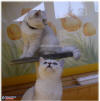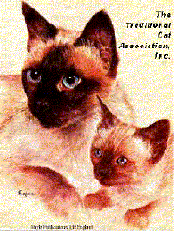|
TRADITIONAL BRITISH
SHORTHAIR © ®
&
TRADITIONAL BRITISH LONGHAIR©® CAT FAQs
HISTORY - PERSONALITY -
HEALTH
Copyright © Trademark ® Diana Fineran, January 2, 2007
Photos Courtesy of Galina Benko of Cheshire Lady Cattery
HISTORY
True to its name the Traditional British Shorthair is a
native of England, where it is probably the oldest English breed of cat. Most
likely their ancestry traces back 2000 years ago to the domestic cat of Rome,
transported by the Roman Empire to Northern Europe and to their outlying
provinces such as the British Isles. Always prized for their strength and
hunting ability, they earned the love and respect of people in their long
history. They come in both Short Hair and Long Hair varieties.
For hundreds of years they roamed the cities and farms of
England. Only until the 1800’s and the advent of the first cat shows in 1871,
were they bred for type, color or pedigree.
By 1910 the top cat was the Silver, Tabby, Male, CH Jimmy,
owned by Mrs. Louise Herring. At that time the female top winning cat was CH
Jimmy’s sister, CH Laurel Queen, owned by C.H. Lane. The show prowess of these
siblings caused many to take notice of the British Native.
Very early on many Traditional British Shorthairs were
exported to the U.S. The first one registered in the U.S. was in 1901. He was
a male, red, tabby named, Belle of Bradford, imported by Jane Cathcart.
Photos Courtesy of Galina Benko of Cheshire Lady Cattery
Early breeders in England were Lady Alexander (Ballochmyle
– prefix), C.H., Lane (Laurel – prefix) and Lady Decies (Fulmer).
World War I brought the British Cat Fancy to a dead stop
until the war was over. Loss of breeding cats resulted in breeders having a
difficult time finding registered Traditional British Shorthairs to use, so they
introduced un-registered domestic cats, which caused a lack of type. Thus they
lost the winning prowess previously enjoyed. In an attempt to take a short cut
to regain type, some breeders out crossed to Persians. The British registry
refused to register the resulting kittens or allow them to be shown. Three
generations of breeding those kittens back to Traditional British Shorthairs
opened the doors to the British Registry again. By then Persian and other
shorthairs had gained popularity, so the Traditional British Shorthair declined
in numbers.
 Miss Kit Wilson took on the breed in the 1930’s. through
her work and that of others the breed was sustained through the Depression and
the Second World War. Once again, only a few remained for breeding and were to
closely related. To re-gain a strong gene pool un-pedigreed domestic shorthairs,
Russian Blues, Burmese, and Chartreux were added to the breed. The result was
loss of type again to a more foreign look, so Persians were used again. This
became a struggle to keep away from such Persian attributes of a pug face and
long fur. It took great effort to get the breed to breed true again.
(Photo Courtesy of Olga Osipova) Miss Kit Wilson took on the breed in the 1930’s. through
her work and that of others the breed was sustained through the Depression and
the Second World War. Once again, only a few remained for breeding and were to
closely related. To re-gain a strong gene pool un-pedigreed domestic shorthairs,
Russian Blues, Burmese, and Chartreux were added to the breed. The result was
loss of type again to a more foreign look, so Persians were used again. This
became a struggle to keep away from such Persian attributes of a pug face and
long fur. It took great effort to get the breed to breed true again.
(Photo Courtesy of Olga Osipova)
Silver Tabbies were exported to the U.S. in large numbers
early in the 20th century. They were still called Domestic
Shorthairs until the 1950’s when they were first known as the “British Blue”,
because of the breeds only original color. They are now accepted in a rainbow of
cat colors.
In 1967 Mrs. Levy of Long Island, NY imported Pensylva
Damcus and Pensylva Blusette from Mrs. Joan Richards British cattery. This pair
became the first U.S. Champions in the breed. Later came Manana Channaine, who
turned the tide and finally got them recognized as Traditional British
Shorthairs.
Photos Courtesy of Galina Benko of Cheshire Lady Cattery
PERSONALITY
They have won the hearts of owners all over the world due
to their easy going nature, intelligence, calm demeanor, endurance and loyalty
to man. Quiet supervising of all their surroundings and happenings in their
family keeps them in touch with their environment. Since they are bigger in
size, they prefer to be on the ground, so they are not acrobats or speed demons.
They can be embarrassed when they make a miss-step, but quickly recover. Alert,
playful, undemanding, refined, sweet, gentle, unpretentious, serene and
dedicated they make calm, quiet companions.
Photos Courtesy of Galina Benko of Cheshire Lady Cattery
HEALTH
They are comparatively small in numbers in the U.S.
However, imports from England, Ireland, Australia and New Zealand added to the
widening of the U.S. gene pool and added to the health of the breed. Their short
coat is very easy to groom. They are strong cats with few health problems.
Kittens are vigorous and large at birth and their eyes open
in less than a week. Growth spurts as common with the kittens so they go through
many stages. Moms have very little birthing problems.
Since they carry both cat blood types of A and B. Blood
typing and testing helps breeders make informed, planned breedings so very few
problems with blood types are experienced.
|

 The
Traditional Cat Association,
Inc.©1987®TM
Official Website
The
Traditional Cat Association,
Inc.©1987®TM
Official Website














